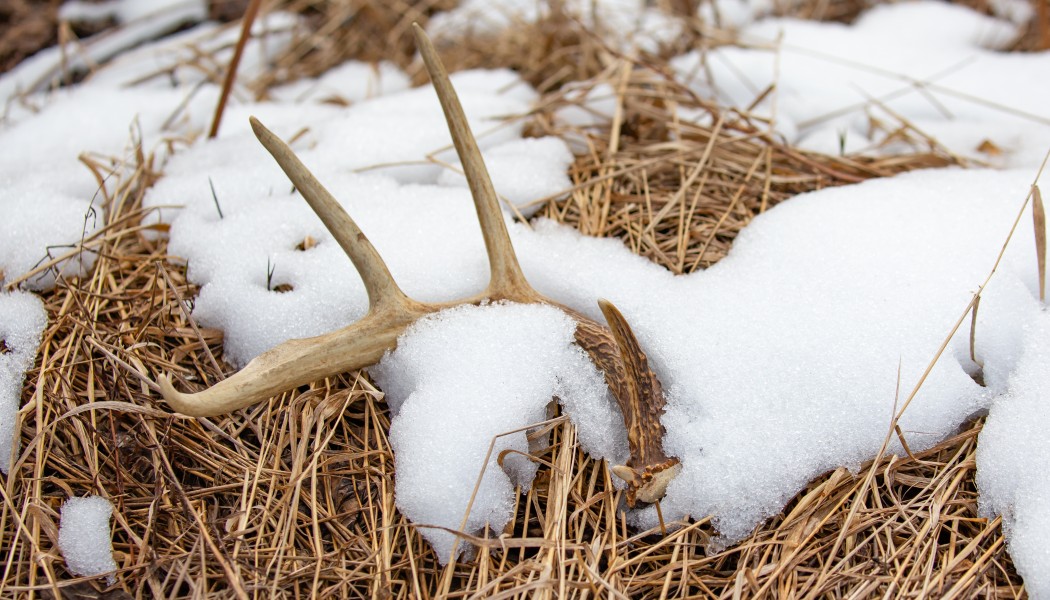
While deer hunting in the traditional sense may be over for the year, there’s another way you can prolong your season. Shed hunting with trail cameras is a way for you to get back into the field, do some postseason wrap-up and reconnaissance, and have one more chance to get your hands on the big buck that eluded you during the regular season.
Male deer shed their antlers and grow a new set every year. Depending on geography and climate, shed season can start as early as late-January and stretch through March and possibly even into early April. Age, health, and nutrition also play a role in when a buck will shed his antlers. Every buck is different, no two will likely drop their antlers at the exact same time, and the same deer may drop at different times from year to year.
Even though the antlers may be on the ground, it doesn’t always mean they are fair game. Believe it or not, there are actually shed hunting seasons and shed hunting laws in some states. Make sure you consult with the game wardens or the equivalent in the area in which you plan on shed hunting to make sure that what you pick up is both in season and legal to possess.
Shed hunting can help tell you a lot about the deer in the area. You can figure out where they’re feeding, where they’re bedding, how they’re traveling, and even the quality of the bucks in the area. It’s also a great way to confirm that the big one that got past you actually made it through the season and isn’t in some other hunter’s freezer and on their wall.
When it comes to shed hunting gear, the entry point is pretty low. All you really need are a good pair of boots and the eyes that you were born with. Aside from that, a good pair of binoculars is a big help. Having a map or software of the area you’re hunting can be helpful in setting up grid areas on a specific shed hunting map to make sure you cover all of a specific area and don’t miss any crucial spots.
Start with open areas
A keen set of eyes aided with a pair of binoculars can help you easily spot shed antlers at a distance. Keep in mind, though, that you may not see the entire antler all at once. Be on the lookout for one or two points and try to visualize all of the different angles from which you’ve seen antlers. They don’t always land on the ground conveniently with all the points visible.
Check food sources
Deer will be spending a good amount of time feeding in the colder weather. Not only do they need the energy provided to survive, but if they were particularly active during the rut, they need to recoup what they lost. Logic dictates that there’s a high likelihood of finding sheds in places where deer spend a large amount of time. This could be natural or planted food plots plus nuts from trees. Locate some acorns and you may well locate some antlers, too.
Monitor fence and water crossings
As antlers loosen up, the jolt from jumping over a fence or hopping over a stream can sometimes be just enough force to knock the antlers loose. Sometimes they’ll get stuck on the fence rails or wire, but more often than not, they’ll be on the ground close by. Similarly, look on the banks of streams along known trails, and don’t forget to actually look in the water.
Use your trail cameras
Keep an eye on the bucks that are showing up on your cameras after deer season ends. If you start seeing deer with only one antler on their heads or spotting a buck with the open wounds where his antlers were, then you know that shed season has begun. It’s time to start looking.
In addition to being a good way to keep an eye on whether or not the deer are actually dropping their antlers, you may actually get lucky and just so happen to see a shed antler in view of your camera on one of the photos that get transmitted to you. If that’s the case, then you know exactly when and where that shed antler showed up and it’s super easy for you to go track it down before anyone else does.
If you happen to be on private property, you can even use your trail cameras to monitor makeshift shed traps. Setups vary, but this can involve putting down a bait pile and surrounding it with posts that you then string up a piece of string or wire at deer head height. As the bucks go in and come out from the bait pile, the string or wire can catch on the antlers and knock them loose. Don’t worry, though: these shed traps aren’t dangerous to the deer and they won’t get caught or hurt in them so long as you set them up properly. Then, put a camera pointed on your shed trap and watch the photos for any shed antlers that appear in or around the bait pile and shed trap.
It doesn’t matter if you choose to shed hunt in open fields or in thickets, on foot or horseback or ATV, on public land or private, by yourself or with friends, with just your eyes or with trail cameras. The end goal remains the same: finding deer antler sheds. For many of us, there’s just as much of a thrill in finding the sheds as there is when a target buck walks in range during regular season.



